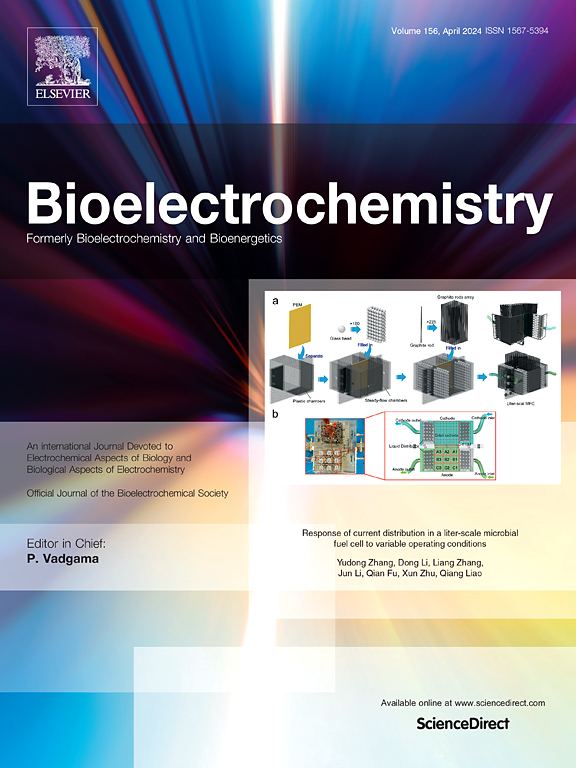基于有机/无机杂化识别元件的新型电导生物传感器测定l -精氨酸
IF 4.8
2区 化学
Q1 BIOCHEMISTRY & MOLECULAR BIOLOGY
引用次数: 0
摘要
采用精氨酸酶、脲酶和氨敏感沸石斜沸石(Clt)共固定化的方法,建立了一种高精度的测定实际样品中l -精氨酸(L-arg)的电导生物传感器。研究并比较了酶组分与沸石在金交叉电极敏感表面不同排列方式的生物传感器。研究表明,与基于其他生物选择膜结构的生物传感器相比,以第一层Clt沉积在电极表面,然后以精氨酸酶和脲酶共固定为第二层的生物传感器具有最有利的分析特性。该传感器的灵敏度为9.61±0.01 μS/mM,检出限为5 μM,线性范围为0 ~ 280 μM,动态范围为0 ~ 15 mM,具有较高的工作稳定性和存储稳定性。研究了溶液参数(pH、离子强度和缓冲容量)对生物传感器灵敏度的影响。最后,利用所研制的生物传感器对食品样品中的l -精氨酸进行定量分析。将生物传感器分析结果与对照方法(离子色谱法)进行比较。生物传感器法所得数据与参考数据具有较高的相关性(R = 0.96)。本文章由计算机程序翻译,如有差异,请以英文原文为准。

A novel conductometric biosensor based on hybrid organic/inorganic recognition element for determination of L-arginine
A highly accurate conductometric biosensor for determination of L-arginine (L-arg) in the real samples with the complex sample matrices was developed by co-immobilization of arginase, urease and the ammonium-sensitive zeolite clinoptilolite (Clt). The biosensors with different mutual arrangements of the enzyme component and zeolite on the sensitive surface of the gold interdigitated electrodes were studied and compared. The studies showed that the biosensor containing the primary layer of Clt deposited on the electrode surface followed by arginase and urease co-immobilized as the secondary layer has the most advantageous analytical characteristics compared to the biosensors based on other configurations of the bioselective membrane. In particular, for this biosensor they were as follows: sensitivity 9.61 ± 0.01 μS/mM, limit of detection 5 μM, linear range 0–280 μM and dynamic range 0–15 mM. The biosensor demonstrated high operational stability and storage stability. The effect of solution parameters (pH, ionic strength and buffer capacity) on the biosensor sensitivity was studied. Finally, we used the developed biosensor for quantification of L-arg in the food samples. The results of the biosensor analysis were compared with the control method (ion chromatography). The data of the biosensor method demonstrated high correlation with the reference data (R = 0.96).
求助全文
通过发布文献求助,成功后即可免费获取论文全文。
去求助
来源期刊

Bioelectrochemistry
生物-电化学
CiteScore
9.10
自引率
6.00%
发文量
238
审稿时长
38 days
期刊介绍:
An International Journal Devoted to Electrochemical Aspects of Biology and Biological Aspects of Electrochemistry
Bioelectrochemistry is an international journal devoted to electrochemical principles in biology and biological aspects of electrochemistry. It publishes experimental and theoretical papers dealing with the electrochemical aspects of:
• Electrified interfaces (electric double layers, adsorption, electron transfer, protein electrochemistry, basic principles of biosensors, biosensor interfaces and bio-nanosensor design and construction.
• Electric and magnetic field effects (field-dependent processes, field interactions with molecules, intramolecular field effects, sensory systems for electric and magnetic fields, molecular and cellular mechanisms)
• Bioenergetics and signal transduction (energy conversion, photosynthetic and visual membranes)
• Biomembranes and model membranes (thermodynamics and mechanics, membrane transport, electroporation, fusion and insertion)
• Electrochemical applications in medicine and biotechnology (drug delivery and gene transfer to cells and tissues, iontophoresis, skin electroporation, injury and repair).
• Organization and use of arrays in-vitro and in-vivo, including as part of feedback control.
• Electrochemical interrogation of biofilms as generated by microorganisms and tissue reaction associated with medical implants.
 求助内容:
求助内容: 应助结果提醒方式:
应助结果提醒方式:


